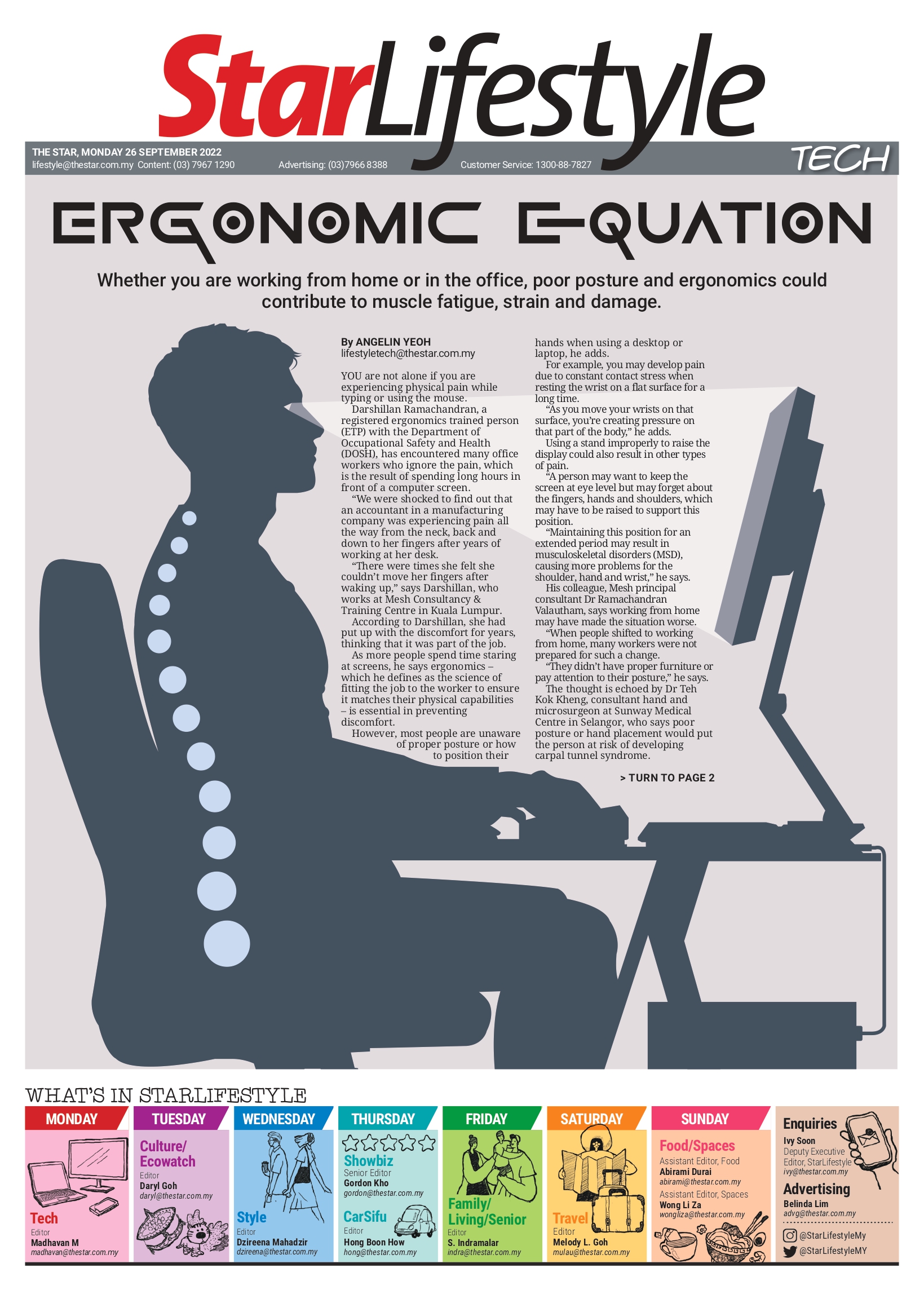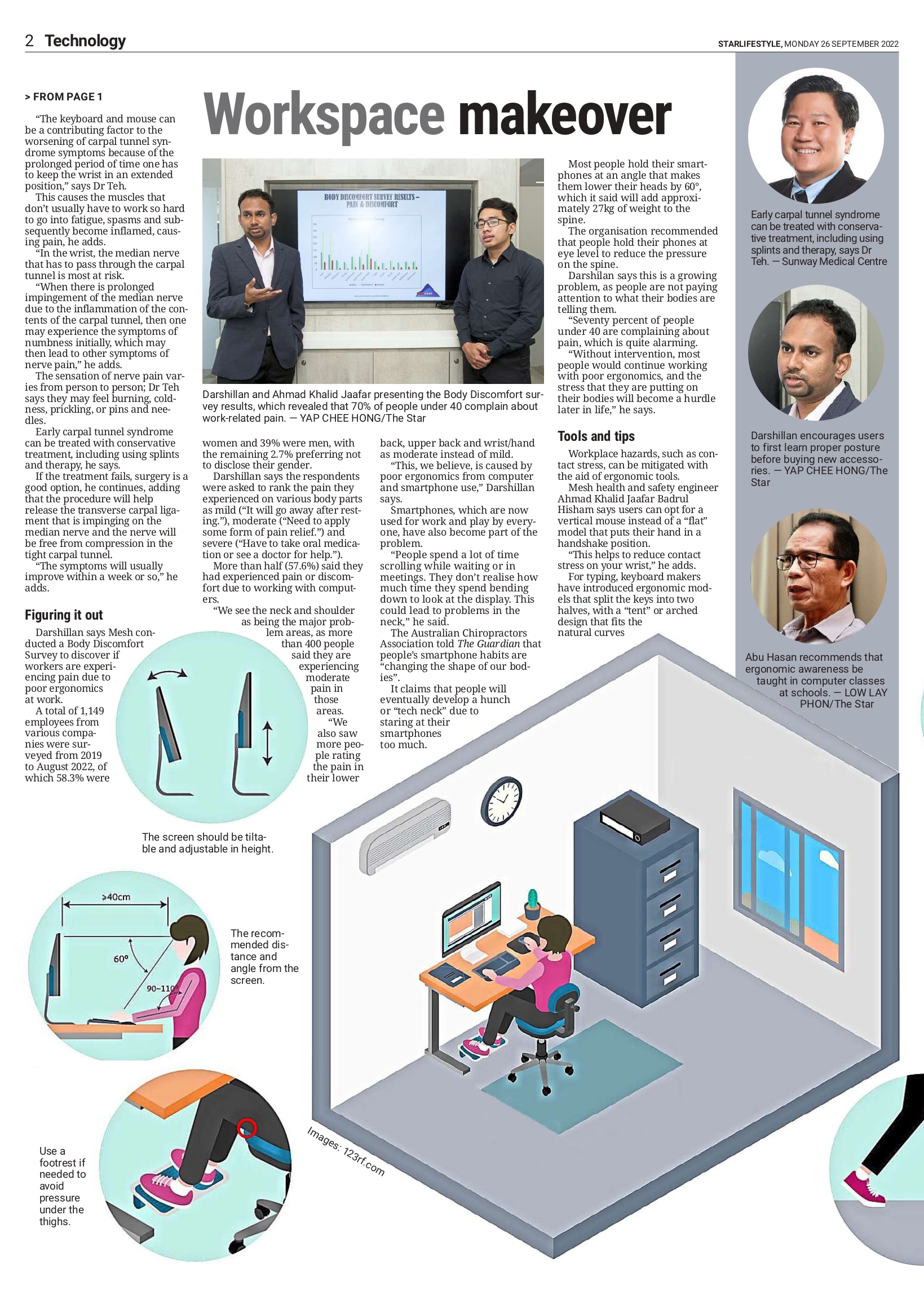Workspace Makeover: The Ergonomic Equation
26 September 2022


You are not alone if you are experiencing physical pain while typing or using the mouse.
Darshillan Ramachandran, a registered ergonomics trained person (ETP) with the Department of Occupational Safety and Health (DOSH), has encountered many office workers who ignore the pain, which is the result of spending long hours in front of a computer screen.
“We were shocked to find out that an accountant in a manufacturing company was experiencing pain all the way from the neck, back and down to her fingers after years of working at her desk.
“There were times she felt she couldn’t move her fingers after waking up,” says Darshillan, who works at Mesh Consultancy & Training Centre in Kuala Lumpur.
According to Darshillan, she had put up with the discomfort for years, thinking that it was part of the job.
As more people spend time staring at screens, he says ergonomics – which he defines as the science of fitting the job to the worker to ensure it matches their physical capabilities – is essential in preventing discomfort.
However, most people are unaware of proper posture or how to position their hands when using a desktop or laptop, he adds.
For example, you may develop pain due to constant contact stress when resting the wrist on a flat surface for a long time.
“As you move your wrists on that surface, you’re creating pressure on that part of the body,” he adds.
Using a stand improperly to raise the display could also result in other types of pain.
“A person may want to keep the screen at eye level but may forget about the fingers, hands and shoulders, which may have to be raised to support this position.
“Maintaining this position for an extended period may result in musculoskeletal disorders (MSD), causing more problems for the shoulder, hand and wrist,” he says.
His colleague, Mesh principal consultant Dr Ramachandran Valautham, says working from home may have made the situation worse.
“When people shifted to working from home, many workers were not prepared for such a change.
“They didn’t have proper furniture or pay attention to their posture,” he says.
Carpal Tunnel Syndrome

Early carpal tunnel syndrome can be treated with conservative treatment, including using splints and therapy, says Dr Teh.
The thought is echoed by Dr Teh Kok Kheng, Consultant Hand and Microsurgeon at Sunway Medical Centre in Selangor, who says poor posture or hand placement would put the person at risk of developing carpal tunnel syndrome.
“The keyboard and mouse can be a contributing factor to the worsening of carpal tunnel syndrome symptoms because of the prolonged period of time one has to keep the wrist in an extended position,” says Dr Teh.
This causes the muscles that don’t usually have to work so hard to go into fatigue, spasms and subsequently become inflamed, causing pain, he adds.
“In the wrist, the median nerve that has to pass through the carpal tunnel is most at risk.
“When there is prolonged impingement of the median nerve due to the inflammation of the contents of the carpal tunnel, then one may experience the symptoms of numbness initially, which may then lead to other symptoms of nerve pain,” he adds.
The sensation of nerve pain varies from person to person; Dr Teh says they may feel burning, coldness, prickling, or pins and needles.
Early carpal tunnel syndrome can be treated with conservative treatment, including using splints and therapy, he says.
If the treatment fails, surgery is a good option, he continues, adding that the procedure will help release the transverse carpal ligament that is impinging on the median nerve and the nerve will be free from compression in the tight carpal tunnel.
“The symptoms will usually improve within a week or so,” he adds.
Figuring it out
Darshillan says Mesh conducted a Body Discomfort Survey to discover if workers are experiencing pain due to poor ergonomics at work.
A total of 1,149 employees from various companies were surveyed from 2019 to August 2022, of which 58.3% were women and 39% were men, with the remaining 2.7% preferring not to disclose their gender.
Darshillan says the respondents were asked to rank the pain they experienced on various body parts as mild (“It will go away after resting.”), moderate (“Need to apply some form of pain relief.”) and severe (“Have to take oral medication or see a doctor for help.”).
More than half (57.6%) said they had experienced pain or discomfort due to working with computers.
“We see the neck and shoulder as being the major problem areas, as more than 400 people said they are experiencing moderate pain in those areas.
“We also saw more people rating the pain in their lower back, upper back and wrist/hand as moderate instead of mild.
“This, we believe, is caused by poor ergonomics from computer and smartphone use,” Darshillan says.
Smartphones, which are now used for work and play by everyone, have also become part of the problem.
“People spend a lot of time scrolling while waiting or in meetings. They don’t realise how much time they spend bending down to look at the display. This could lead to problems in the neck,” he said.
The Australian Chiropractors Association told The Guardian that people’s smartphone habits are “changing the shape of our bodies”.
It claims that people will eventually develop a hunch or “tech neck” due to staring at their smartphones too much.
Most people hold their smartphones at an angle that makes them lower their heads by 60°, which it said will add approximately 27kg of weight to the spine.
The organisation recommended that people hold their phones at eye level to reduce the pressure on the spine.
Darshilan says this is a growing problem, as people are not paying attention to what their bodies are telling them.
“Seventy percent of people under 40 are complaining about pain, which is quite alarming.
“Without intervention, most people would continue working with poor ergonomics, and the stress that they are putting on their bodies will become a hurdle later in life,” he says.
Tools and tips
Workplace hazards, such as contact stress, can be mitigated with the aid of ergonomic tools.
Mesh health and safety engineer Ahmad Khalid Jaafar Badrul Hisham says users can opt for a vertical mouse instead of a “flat” model that puts their hand in a handshake position.
“This helps to reduce contact stress on your wrist,” he adds.
For typing, keyboard makers have introduced ergonomic models that split the keys into two halves, with a “tent” or arched design that fits the natural curves of the hand better.
There are also designs that are fully split, giving users more freedom to adjust the orientation of each half so that both hands are in a comfortable position.
Some models also come with a wrist rest to help reduce contact stress. If it doesn’t, one can be bought separately.
Another important consideration is the chair. Ergonomic models are designed with adjustable features that conform to the user’s needs and support proper posture, preventing the neck and back from developing problems.
If cash is no object, there are tables that allow a user to adjust the height, with some even coming with an app for storing adjustments, allowing different people to use and personalise them.
Darshillan stresses that users should first learn proper posture before resorting to buying new accessories.
For example, when using a keyboard and a mouse, the forearm should be on the table and the wrist in a neutral position.
A neutral position is achieved when the thumb is in line with the forearm and is bent slightly back, like when your arm is hanging at your side.
He also says that users should use the operating system to change how sensitive their mouse or keyboard is to fit their needs.
Meanwhile, Ramachandran adds that the screen should be at eye level to avoid having to glance up or down, and that one should not hunch forward to avoid stressing the shoulder.
When sitting on a chair, a foot rest could come in handy for shorter users, especially for those whose feet don’t touch the ground.
“It helps to push your back against the chair, allowing your body to sit according to its curvature,” Darshillan says.
Dr Abu Hasan Samad, president of the Academy of Occupational & Environmental Medicine, says employees should be better trained about ergonomics, adding that he feels awareness is lacking in Malaysia.
“You may have good tools, but if you’re working with bad posture, putting your laptop in the wrong position or letting yourself work under poor lighting conditions, then you’re going to experience discomfort.
“For example, simple steps like knowing how to adjust the screen brightness or contrast can help reduce glare. Looking too long at a bright screen can be a source of headache for some,” he adds.
On the bright side, some employers are taking tougher measures to encourage employees to take breaks.
Abu Hasan formerly worked for an oil and gas company that used software to track usage – after a specified time, the computer went to sleep, requiring the employee to take a break.
“They will be encouraged to stand up and do some light exercises like stretching. The idea here is to get the worker to not sit or be sedentary for too long,” he says.
Making it work
Abu Hasan urges employees to seek measures to create a safe and comfortable working space, whether it’s through training, tools or introducing breaks.
However, he says he understands why some employees may find it difficult to ask for changes in the workplace.
“Workers may feel that if they voice out concerns, it will affect their relationship with the management or they will not score well during appraisals,” he says.
However, if employees don’t speak up, then their bosses may feel that there is nothing wrong in the workplace, he cautions.
He urges managers to pay attention to factors such as employees taking more sick leave as an indicator that health-related measures may need to be implemented.
To nip the problem in the bud, Abu Hasan recommends that ergonomic awareness be taught in computer classes at schools so students can be better informed when they join the workforce.
“We should start raising more awareness about this issue as we’ll be expected to use more tech tools for more aspects of work,” he says.
Dr Teh advises people to start listening to their bodies.
“If you start to experience pain and discomfort, ask yourself why and take steps to rectify it.
“If the problem persists, then look for qualified help and advice that you can trust,” he says.
Darshillan hopes that more people feel that it’s okay to seek help or address their limitations.
“It’s worrying when we see people develop resistance towards seeking treatment. The issue of ergonomics-related injury is that it’s degenerative in nature – you may not be able to regain 100% of your normal capabilities should you sustain a serious MSD.
“Early intervention is necessary. People should know that seeking help is not a sign of weakness but a desire to change for the better,” he says.
Source: The Star
Back


